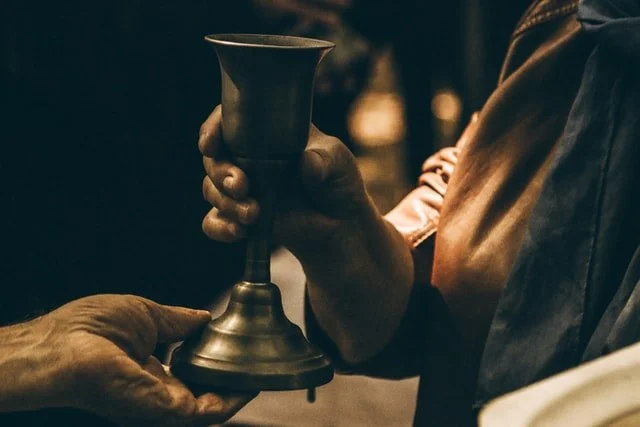How women set the example in this last chapter of Jesus’ life
By Dean Collins
If you are looking for role models in Matthew 26, there aren’t many options. It’s an important chapter, filled with power struggles, lies, deceit, kindness, extravagance, prayer, and sleepiness. It ends with fireside accusations and a quick escape. All total, probably 50 to 100 or more people were involved in the day. We have only a few names, because some were simply mentioned as groups.
The chief priests and elders and the disciples were mentioned first. Jesus, of course, is in the middle of all the day’s events. Simon the leper and a woman with an alabaster bottle of perfume showed up. One person allowed Jesus and the disciples to eat the Passover at their home. Everyone mentioned here was either in the camp of the Jewish hierarchy or among the followers of Jesus except for a few stragglers sitting around a fire trying to decide which team to join or if either was a good choice. Some still sit around watching and evaluating the character and behavior of people of faith each day trying to decide if following Jesus will really change anything.
Last meal
You are familiar with the details of the chapter. It’s the opening scenes we don’t want to read because of the pain, suffering, and abuse of the one we love and follow. With each reading, we marvel at the one we call Lord and what he did for us. Then Jesus tells the disciples it is time to prepare for Passover, the celebration that remembers how God appointed Moses to lead his beloved from the bondage of Egypt and into freedom. The last meal the children of Israel ate was called the Passover and happened the night before they departed and experienced freedom for the first time in more than 400 years.
On that night every Jewish household placed the blood of a lamb over their doorpost. This mark distinguished the houses of the Jews from the Egyptian homes. Because of Pharaoh’s refusal to listen to Moses, Egypt would endure one last and horrible plague, the death of each family’s firstborn son.
Matthew 26 tells us Jesus ate a last meal with disciples on the night of the Passover. Soon he would give his life on a cross for our sins, to set us free from the debt we owe and the bondage of our sins and our past.
We know the names of the disciples due to their frequent mention in the whole of the Gospel records. We don’t know for sure the names of two people in this story. Some scholars have speculated, possibly accurately, about the homeowner who offered Jesus a place to eat his last supper with the disciples. Who was he? We also don’t know for sure the name of the woman with the alabaster jar. Again, scholars have pieced together some reasonable options.
Two heroes
And looking at the chapter as a whole, I think if we were to pick someone we want to imitate, it might be these two unnamed people. One is known for her uninhibited worship that was filled with gratitude and sacrifice. The other was the person who without hesitation or question offered their home so Jesus could host the Passover meal.
I think if we were to pick someone we want to imitate, it might be these two unnamed people.
I remember somewhere reading that Mary was among the most common names for females among first-century Jews. We know of several Marys in the New Testament: Mary, the mother of Jesus; Mary Magdalene; Mary of Bethany (sister of Martha and Lazarus); Mary, the wife of Clopus; Mary, the mother of Mark; Mary, the mother of James. Not every text makes clear which Mary is being referenced. Some cross-checking of other texts helps but doesn’t always solve.
Some are quite confident about each of several theories concerning which Mary is in which place. Wonderful reasons and speculation lead to lots of inspiring possibilities, but frankly, we can be inspired by these women even when we don’t know for sure which person we’re reading about.
Some scholars suggest the last supper was held in the home of Mary, the mother of Mark because Acts12:12 tells us Peter went to Mary’s house after the angel led him out of prison. This house was large enough for the disciples and others to gather for prayer. Many think the man who offered the house was the head servant who ran the house for Mary who was thought to be prominent and wealthy.
Prominent women
It shouldn’t surprise us that women played prominent and sacrificial roles in serving Jesus during his ministry and in the life of the early church. Jesus was clearly comfortable with women serving in many significant ways during his ministry. I suspect you would agree that it’s hard to imagine how any congregation anywhere could or has survived without the tireless service of women in the local church.
Jesus said the woman who risked reputation and controversy showing up at Simon’s house did a beautiful thing when she offered a valued possession and poured the perfume on Jesus’ head. Jesus once again showed he both knew the Scriptures and read the hearts of his followers better than anyone else in the room.
When we allow Jesus to continue his transformation work in our hearts and guide our understanding of Scripture, then maybe we will behave more like these women than the dozens of men in the storyline of Matthew 26.
Your time with God’s Word
Matthew 26, ESV
Photo by Jametlene Reskp on Unsplash
To receive daily posts delivered directly to your inbox, complete the form at the bottom of our home page.
To download a printable version of today’s post, click here.

